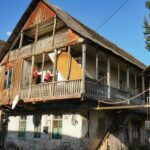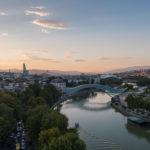Bolnisi, Georgia. The capital of the Bolnisi district is in the heart of the state of Kvemo Kartli (Lower Karlti). This region lays claim to an off-track, but entirely international-level history. Namely, the oldest evidence of Hominin life outside Africa (in Dmanisi, 1.85M Years), the oldest evidence of winemaking in the world (Gadcharili Gora, 6000 BC), and the largest historic German (Swabian) settlement in Georgia (Bolnisi, aka Ekaterinenfeld / Katharinenfeld).
If this wasn’t already enough of a reason to visit, the area is brimming with scenic valleys, mountains and canyons, and medieval history in the form of fortresses and ancient cathedrals. Not to mention the incredible 19th century German buildings in Bolnisi & Asureti.
And, in case you are still not convinced to spend a day or three in the region – it’s a fertile valley full of food, wine, and Georgian hospitality, and only an hour or so from Tbilisi. Also, keep driving a little, and you’ll be in Armenia!
In the below Bolnisi travel guide, you’ll learn more about all the reasons to visit Bolnisi, Dmanisi, Asureti, Dashbashi, and more parts of Kvemo Kartli. What to do, where to eat and drink, and where to stay, as well as my 1, 2, and 3-day Bolnisi Georgia regional itineraries. Or take a fully guided premium wine, food & history tour to Bolnisi.
Also, find my Bolnisi Map below with all the essential points of interest listed in one place.
5 Amazing Reasons To Visit Bolnisi, Georgia
The 5 core reasons to visit the Bolnisi Georgia area in Kevmo Kartli
- 1. Dmanisi: 1.85 Million-year-old archeology of Homo Erectus – the oldest evidence of hominid life outside of Africa.
- 2 & 3. Bolnisi (Ekaterinenfeld / Katharinenfeld) & Asureti (Elisabethtal): Incredible 19th-century German (Swabian) settlements. Explore old German architecture, wine cellars, and a fusion of Georgian and German food and wine culture. Here you can taste German-style ham and Rkatsiteli wine blended with Reisling!
- 4. Wine History: Gadcharili Gora: At The very eastern end of this valley, you’ll find Gadcharili Gora, the site where the oldest evidence of winemaking in the world was discovered. Proving wine was made here more than 8000 years ago.
- 5. It’s just plain scenic! And off the regular tourist trail.
There are also other regional attractions – fortresses, canyons, and incredible scenery in this beautiful and fertile region of Georgia. This article will discuss all the highlights surrounding Bolnisi, Georgia. But let’s first take an in-depth look at the top 5, some essential history and information.
Explore this top 5 on a fully guided wine, food & history tour to Bolnisi region.
1. Dmanisi – 1.85 Million Years Old Homo Erectus Archeological Site
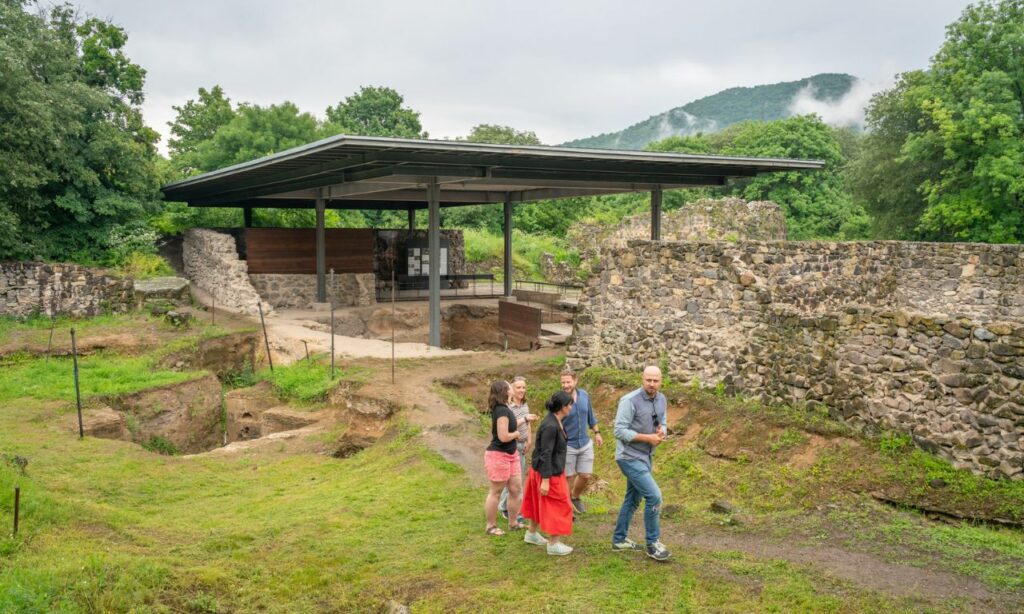
NOTE: Dmanisi Archeological site is open seasonally. Normally from May to October. However, the exact start and end date for the season is not fixed. Always call in advance to avoid disappointment. If visiting out of season, visit the Bolnisi Museum instead.
Excavations at Dmanisi have unearthed the remains of hominins dating back about 1.85 million years, making these fossils the oldest evidence of early humans outside Africa. The discoveries include five relatively well-preserved skulls, as well as stone tools and animal bones. These finds have led to a reassessment of the timeline and pattern of human migration out of Africa and into Eurasia.
The skulls, which display a mix of primitive and advanced traits, have been classified as Homo Erectus, one of our early human ancestors. Notably, the cranial variation among the Dmanisi individuals is surprisingly large but no larger than the variation seen in modern human populations. This finding challenges the traditional understanding of human evolution and suggests that several contemporary species of early Homo, including Homo habilis and Homo Rudolfensis, might represent variation within a single, evolving lineage.
Moreover, the stone tools unearthed at the site indicate the presence of technology and further emphasize the advanced capabilities of these early humans. The presence of such tools outside of Africa points to the broader geographic distribution of early technological innovations.
As well as the dig site and visitors center, a walk up to St. Virgin Mary Cathedral will reveal a canyon, mountain tops, and a rolling valley in the distance.
The Dmanisi site is around 2 hours south of Tbilisi. You pass through Bolnisi to reach it.
2. Bolnisi German (Swabian) Settlement
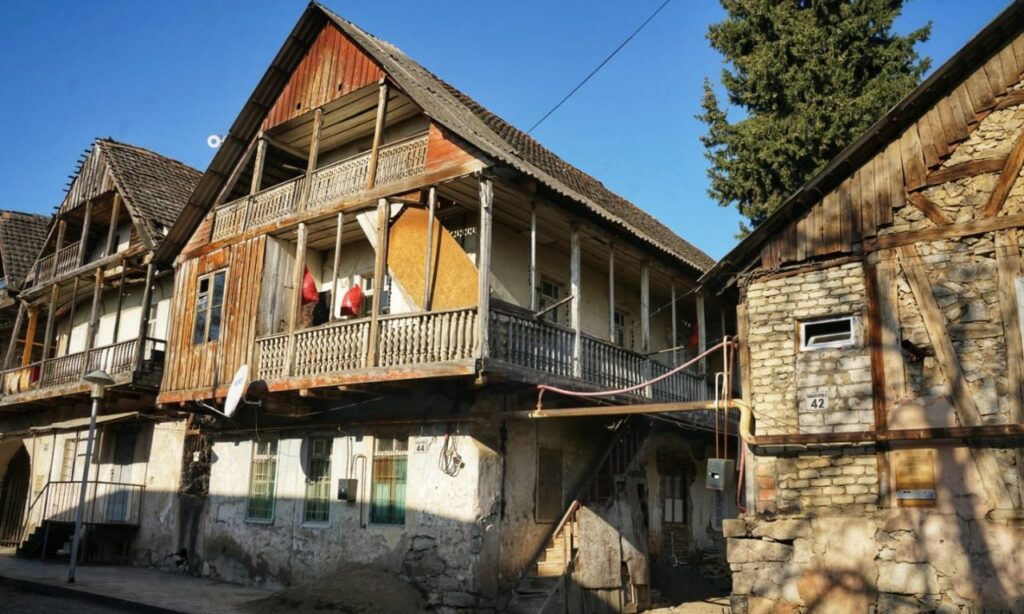
From 1817 German (Swabian) settlers, at least 531 families in total, migrated into the South Caucasus. Many of them ended up in Bolnisi (Yekaterinenfeld or Ekaterinenfeld (Russian) / Katharinenfeld (German)) which became the largest German settlement in Georgia. They built wonderful German-style buildings, with deep wine cellars. They started brewing German beer and making wine in the German way.
Visit here: for a full guide on the history of Bolnisi and German settlement in general.
A quick summary of highlights and history in Bolnisi is below.
Bolnisi is the modern Georgian name for what was originally a German (Swabian) settlement. Its former names include Yekaterinenfeld or Ekaterinenfeld (Russian) and Katharinenfeld (German). Below is a brief summary of the history of the city.
- Originally Bolnisi was established in Azerbaijan in 1818. But in 1819, it moved to its present location.
- At the time it was named: Katharinenfeld in honor of Katharina, queen of Wüttemberg.
- The oldest settlement core of Katharinenfeld is located in the area of today’s streets Shota Rustaveli (formerly Garden Street), Giorgi Saakadze and Stefania (formerly Katharinen Street), King Pharnavaz Street (formerly Nikolai Street), Merab Kostava (formerly “Church Street”) and Egnate Ninoshvili (formerly Mill Ditch Street). (The area is marked on our Bolnisi Map below)
- The main church in the center was consecrated in 1854. The bell tower was destroyed by the Soviets, the building was extended and is used as a sports hall today.
- It became the largest and most developed German settlement in Georgia.
- In 1916 the name was changed to Ekaterinovka. Then in 1921 upon Soviet occupation of Georgia, to Luxemburg in honor of the Polish-German communist Rosa Luxemburg. In 1943, the village finally received its current name Bolnisi.
- In 1941, due to Germany being at war with the Soviets, All Germans in the town apart from women married to Georgian men, were deported to Kazakhstan and Siberia.
- The modern city of Bolnisi retains many of the original German buildings from the mid to late 19th century, which replaced the original mud huts from the 1820s. Many are in a poor state of repair, but renovation projects are underway and Bolnisi will soon become a glorious testament to its German past.
- Most of the traditional German buildings have original wine cellars, a few winemakers have theirs available to visit (book a wine tasting) and the municipality recently opened one renovated cellar for public visits.
A 45-minute walk around the central old town is currently enough to get a real feel for the architecture and history. But a visit to a German cellar is a must-do as well.
Learn more about what to see and do around Bolnisi in the attractions and food/wine sections below.
See our Bolnisi Map below for locations and options.
3. Asureti German (Swabian) Settlement
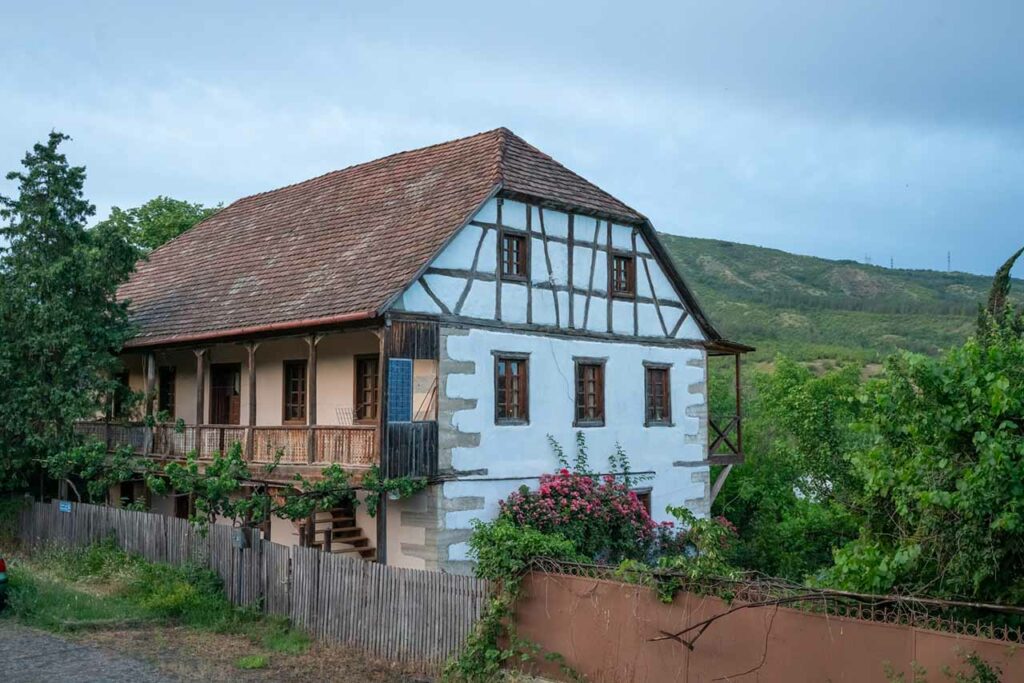
The German Settlement of Asureti (Elisabethtal) is significantly smaller than Bolnisi but makes for a lovely 20-minute stop on the way between Tbilisi and Bolnisi. Spend longer here to enjoy a visit to a wine cellar or restaurant.
- Established in 1818, Elisabethtal – is today the village of Asureti in Tetritskaro municipality.
- The majority of the old 19th-century buildings run along the central Chavchavadze street.
- At the Northern end, the Asureti Cathedral, which was consecrated in 1871.
Learn more about what to see and do around Asureti in the attractions and food/wine sections below. Locations are marked on the Bolnisi tourist map below.
4. 8000 Year Wine History, Georgian-German fusion winemaking & Gacharili Gora
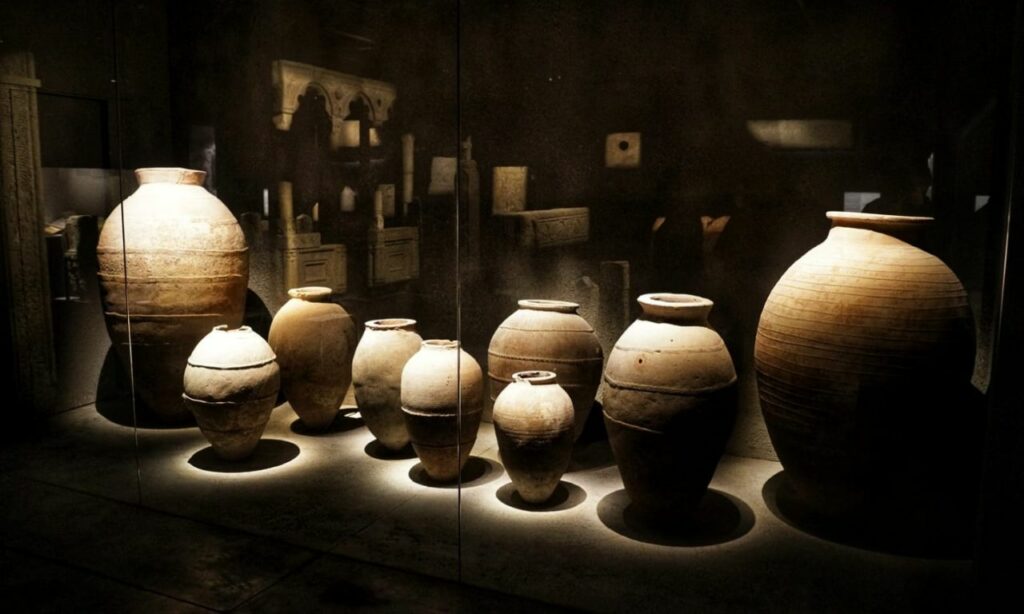
8000 years of Georgian wine history of the region, in a nutshell.
- On a small piece of land, 20 miles south of Tbilisi, lies the archeological dig site of Gadachrili Gora. Here they discovered pieces of pottery, stained with wine, which have been carbon-dated to around 6,000 BC.
- This evidence shows that people living off the land in that area 8000 years ago, must have been making wine and storing it in clay pots. Grapes, slightly crushed into pots and left to ferment into wine via natural yeasts on the skins and sugar in the grapes.
- This traditional winemaking method spread around Europe. It remained the primary method for making wine in Georgia until the 19th century.
- From the 19th century, the first European classical wines were being made in Georgia. It’s believed that Prince Alexander Chavchavadze (1786-1846), who lived in the Tsinandali estate in Kakheti, east Georgia, was the first to make wine and bottle it in this way.
- German settlers arrived in 1817 to Tbilisi and regions of Georgia. They brought their own wine production methods with them. Large oak vats for fermentation and digging deep wine cellars. They also cultivated non-Georgian grape varieties, such as Riesling, along with exploring and even discovering local grapes (like Asuretuli Shala, a wild grape found by a German man called “Shala” near to the settlement of Asureti).
- Phyloxerra decimated natural vines across the world, including much of Georgia in the late 19th and early 20th centuries. From 1921 the Soviet Union occupiers turned winemaking in Georgia into an industrial machine. Quantity over quality was the goal. The highest-yielding grape varieties were planted in huge numbers. Planting of lesser yielding grapes was banned. Many rare grape varietals were lost during this time.
- In the 21st century, as Georgia has recovered from Soviet rule, winemakers have started to focus more on quality and rare grapes, as well as more experimentation when making bio wines. Bolnisi (2018) and Asureti (2022) have both been granted PDO status recently.
The Gadcharili Gora historic site is just a hole in the ground, currently, there is no visitors center or information. If you happen to be travelling with an expert guide then a short detour may be worth it, if not, it’s better to visit the Bolnisi Museum to learn more – see below.
In Bolnisi and Asureti you will find old German wine cellars, using a mixture of qvevris, wooden vats, steel tanks, and glass containers to produce wine. Blending local grape varietals like Rkatsiteli, Saperavi, and Tavkveri with international ones like Riesling, Muscat, Muhle Chardonnay, and more.
5. Off-Track Tourism With Stunning Scenery
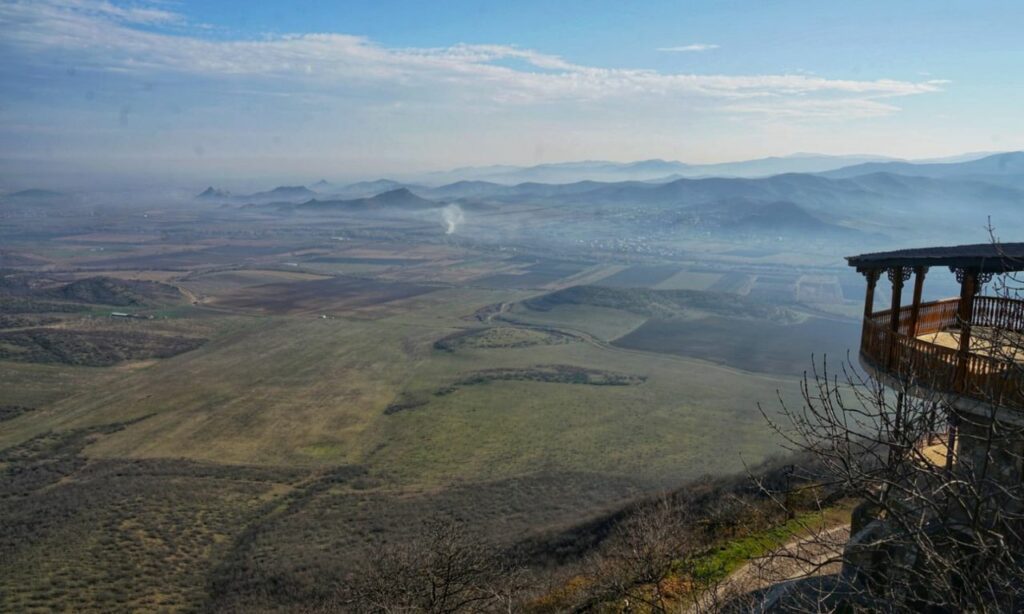
A full list of attractions and scenic stops is below in the top attractions section. But, in general, like many parts of Georgia, the mix of mountains and valleys comes together to provide visitors with incredible, photo-worthy scenery.
The valley where Bolnisi is located is very fertile, unlike further east towards Rustavi and then David Gareja monastery, which are very arid areas. As you drive south from Tbilisi and turn west towards Bolnisi, you move from arid yellowing summer landscapes to green rolling hills and mountains to the north and south.
Stopping at St Peter & Paul’s Monastery (Bolnisi Zedashe), 10 minutes south of Bolnisi center, you can drive to the very top for epic 360-degree views of the valley. As you travel onwards to Dmanisi archaeological site, you eventually enter a more narrow river gorge, which winds its way towards the Armenian border.
Explore this top 5 on a fully guided wine, food & history tour to Bolnisi region.
How Long to Spend in Bolnisi Georgia Region? When to visit?
1 to 3 days is sufficient for any standard tourism. But it’s a very relaxing, off-track destination, especially for wine lovers, who could easily spend a week or more exploring the various German-Georgian wineries.
The main settlement of Bolnisi is about 1h10m south of Tbilisi’s old town, making day trips pretty simple. The Dmanisi archaeological site is closer to 2 hours from Tbilisi, so including that in your one-day trip makes for a longer day.
It’s certainly possible to mostly explore the 3 main highlights of the region (Dmanisi / Bolnisi & Asureti / Wine History) in 1 day. It’s quite a busy day and 2 days is a little more relaxed. Taking 2 to 3 days can mean you can also visit other local attractions, take it a little easier and enjoy more wine and food.
Bolnisi is lovely year-round, with no rainy season, milder summers than Tbilisi (though still hot) and moderate winters, though it can snow. In general, it’s similar to Tbilisi but stays a little greener due to a very fertile topography.
May to October is the best time to visit purely because the Dmanisi Museum is only open seasonally, and it’s one of the most important reasons to visit. The area is already not very touristy, so if you visit in winter you may pretty much have the majority of attractions to yourself!
Additional Top Attractions in Bolnisi & Kvemo Kartli Region
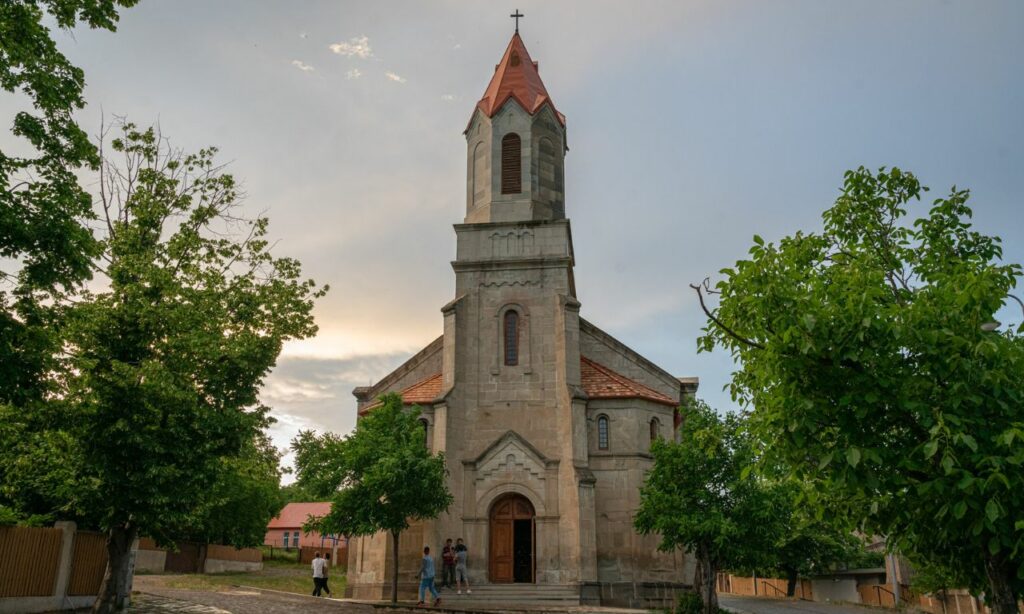
Already Discussed above:
- Dmanisi Museum / Archeological Site
- Bolnisi Old German Center
- Asureti Old German Center & Cathedral (pictured)
- Gadcharili Gora Archeological Site / 8000 Year Wine History
If you want a fully guided, all-inclusive trip with plenty of food and wine to try, and an expert guide to do the driving for you, please check out Eat This! Tours. Currently, they offer Bolnisi routes on-demand, but as the region grows more popular, scheduled tours will become available.
St Peter & Paul’s Monastery – “Zedashe” Bolnisi Panoramic Views!
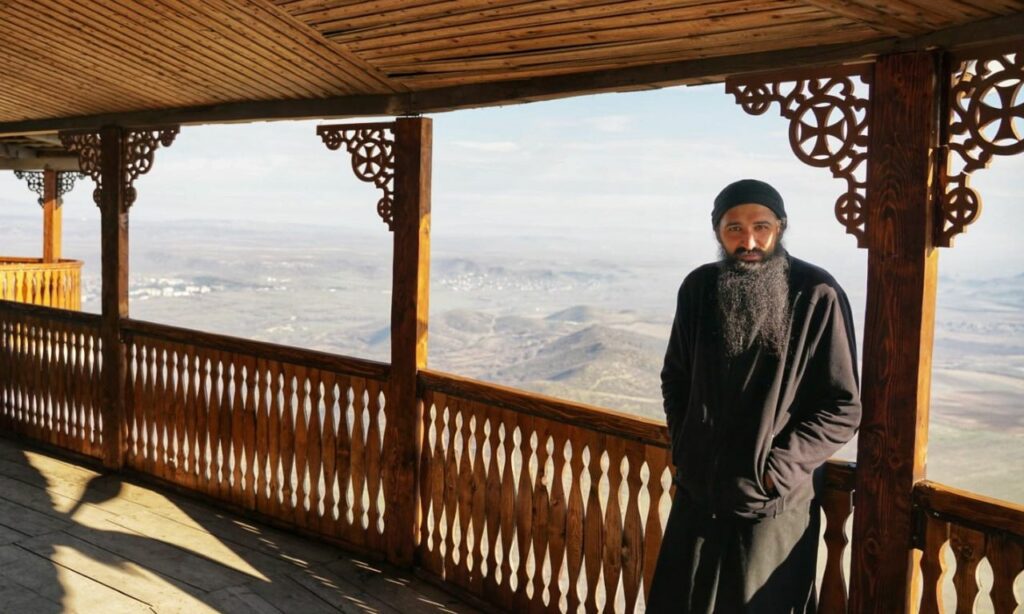
At the top of a solitary peak in the center of the valley, the Zedashe has unparalleled 360-degree views with mountains in every direction. The monastery itself has been newly constructed, and completed in 2008. They also make wine, with their marani (wine cellar)which is built into the solid rock. Currently, however, there is no wine tasting or much to visit in terms of the monastery, it’s not really open to the public. But the wrap-around terrace is open and the drive up the steep hill (possible without a 4×4) is well worth the view as a reward. In fact, it’s one of the scenic highlights of the whole region.
Bolnisi Museum
Nominated for the European Museum of the Year Award 2022, the new Bolnisi museum, located on the highway as you enter the city of Bolnisi, covers all the most essential local history. In a nutshell, the 3 core reasons to visit this area – 1.85M year Homo Erectus, German/Swabian settlement, 8000-year wine history/archeology – are all explained in-depth, with great exhibits.
If you are on a very short trip, especially if traveling without a professional guide, then a 1-hour visit here will get you up to speed on all the essentials of the area. If the museum at Dmanisi is closed, then this is also the only alternative.
Closed Mondays.
St. Virgin Mary Cathedral of Dmanisi

Dating back to the 6th century, this iconic cathedral sits on a ridge above a spectacular canyon. It’s just a few minutes walk from the archaeological site of Dmanisi. So, if you are making the walk up the hill anyway, this is absolutely worth a 20-minute stop.
The cathedral’s architecture is an amalgam of different periods. The archaic stone structure, adorned with intricate carvings, radiates a quiet but profound grandeur. This historic ambiance is heightened when sunlight filters through its ancient windows, painting an ethereal mosaic of light and shadow.
Samshvilde Fortress & Canyon
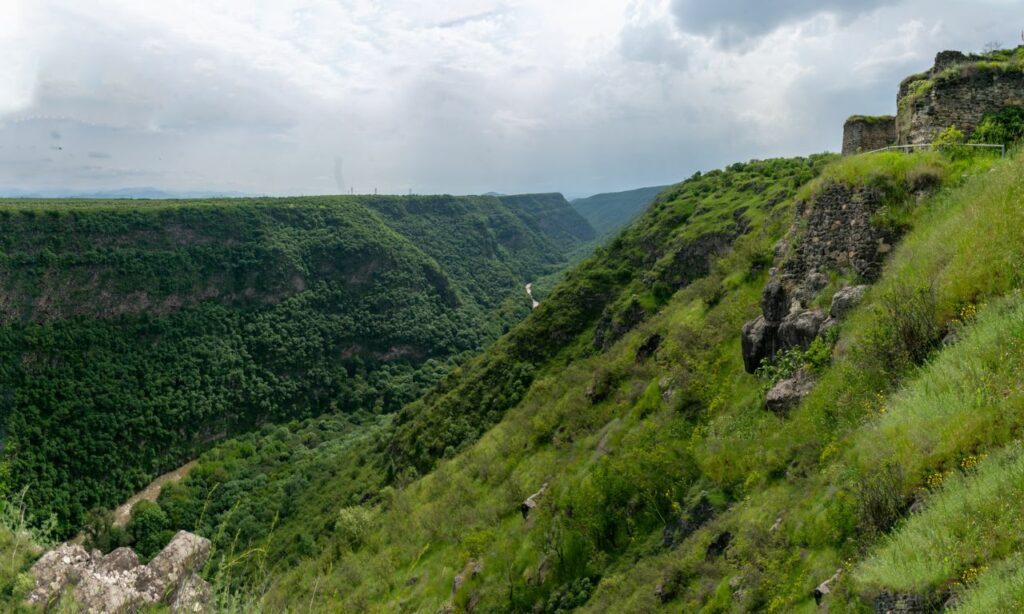
Established in the 3rd century BC, this ancient fortress city bears silent testimony to the ebb and flow of empires. Now an archaeological reserve, it enchants history buffs with its partially preserved walls, citadel, and various other structures that whisper tales from the past.
The equally striking Samshvilde Canyon surrounds the fortress, showcasing the rugged beauty of the Georgian wilderness. Carved by the Khrami River, the canyon presents an enticing mix of panoramic views & intriguing rock formations.
The access road needs a 4×4 if it has rained recently, even so, it’s a rough road so may not be an easy drive up the hill in a basic vehicle. From the parking area, a serene walk along the old settlement street (partly overgrown) needs about a 1-hour roundtrip to reach the fortress and photograph the canyon. Very non-touristy, mainly only locals are visiting this site.
Bolnisi Sioni Cathedral
Founded in the 5th century, it is among the oldest Christian establishments in Georgia, symbolizing the nation’s early adoption of Christianity.
The monastery captivates with its blend of architectural styles, influenced by various periods. Its enduring stone walls, coupled with intricate carvings, narrate a saga of faith and resilience. Notably, the locally famous “Bolnisi Cross”, Georgia’s oldest cross symbol, is etched into its structure, adding to its historical significance.
Dashbashi / Edzana Canyon Bridge
Revered as one of the most beautiful and distinctive canyons in Georgia, Dashbashi, with its vertical walls and dense vegetation, is a testament to the relentless beauty of the natural world.
At the heart of the canyon, the Khrami River creates picturesque waterfalls. Surrounded by lush, wild flora, these falls offer a delightful retreat for nature lovers and photography enthusiasts alike.
Adding to the mystical allure of Dashbashi is the ancient cave monastery, wedged into the canyon’s cliffside. This spiritual sanctuary, believed to have been active since the 6th century, resonates with historical significance and whispers tales of historic monastic life.
The most recent addition, opened in 2022 is the man mad diamond bridge and restaurant, suspended above the canyon. You can ride a bicycle across a tightrope here (secured, not loose!) if you dare!
For an exploration of the canyon and waterfalls, allow at least 2 hours roundtrip, and there are park fees to pay. For sightseeing tourists on a fast trip, a quick stop at the diamond bridge for views into the canyon is typical.
Kveshi Fortress
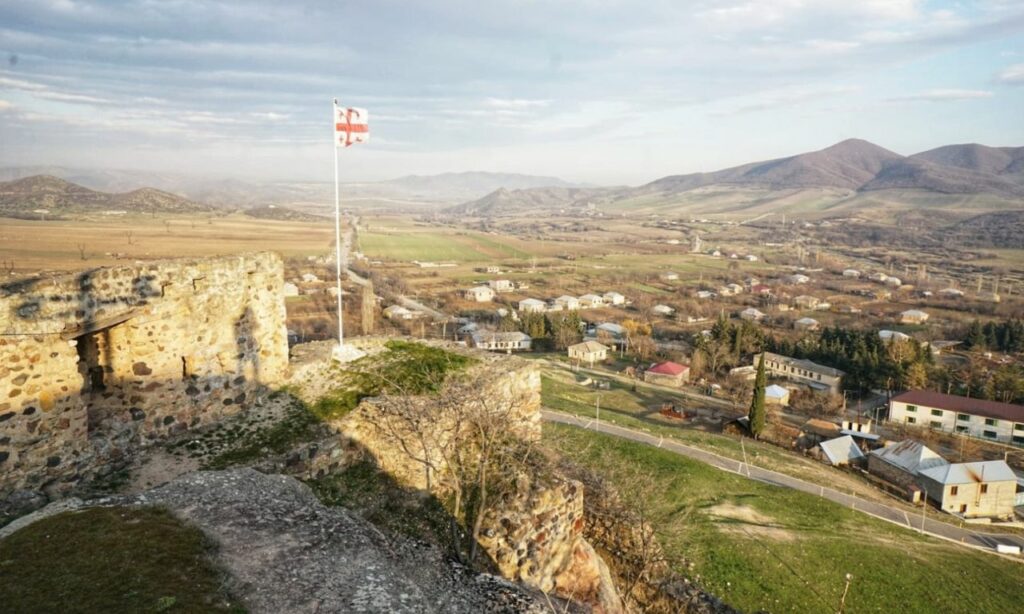
Erected in the 9th century, Kveshi Fortress is a testament to the country’s turbulent past – sitting as a central icon in the middle of the valley, monitoring the ancient trade routes and invaders who would have passed up and down. This ancient bastion, perched high on a cliff, offers visitors a glimpse into the medieval age, with its partially preserved walls and structures narrating timeless tales of courage and resilience.
Beneath the fortress lies the beautiful Kveshi Canyon.
Access is just a 3-minute drive up a paved road from the main highway, so if heading to or from Dmanisi, this makes for an easy 20-minute stop.
Other Minor Attractions
Tsalka Lake
Undeveloped and relatively sparse, if you are visiting Dashbashi Canyon and looking for a peaceful place to pause nearby, a short visit to Tsalka Lake can provide.
Didgori Battle Memorial
Commemorating the iconic Battle of Didgori in 1121, where the Georgian King David the Builder (who ushered in Georgia’s golden age) achieved a decisive victory against Seljuk forces, the memorial stands as a monumental tribute to Georgian bravery and unity.
The memorial, constructed in 1997, features 15-meter tall sword-bearing figures and more than 90 horsemen etched in stone, all descending the hillside to create a dramatic visual narrative of the historic battle.
It’s also a very scenic spot with views in all directions, towards mountain peaks and more.
Manglisi Sioni (Cathedral)
Dating back to the 6th century, Manglisi Sioni is one of the oldest Christian sites in the country.
The cathedral, built with local white stone, captures the essence of early Georgian architecture. Its beautifully carved facades and ornate interiors, depicting biblical scenes and figures, create a mesmerizing testament to the nation’s artistic prowess and deep spiritual devotion.
Unlike many other religious buildings in Georgia, it lacks the epic scenery of places like Jvari Monastery, Nekresi (Kakheti), or the Zedashe of Bolnisi. But if you are heading back to Tbilisi from Dashbashi it’s a worthwhile detour.
Shavnabada Monastery
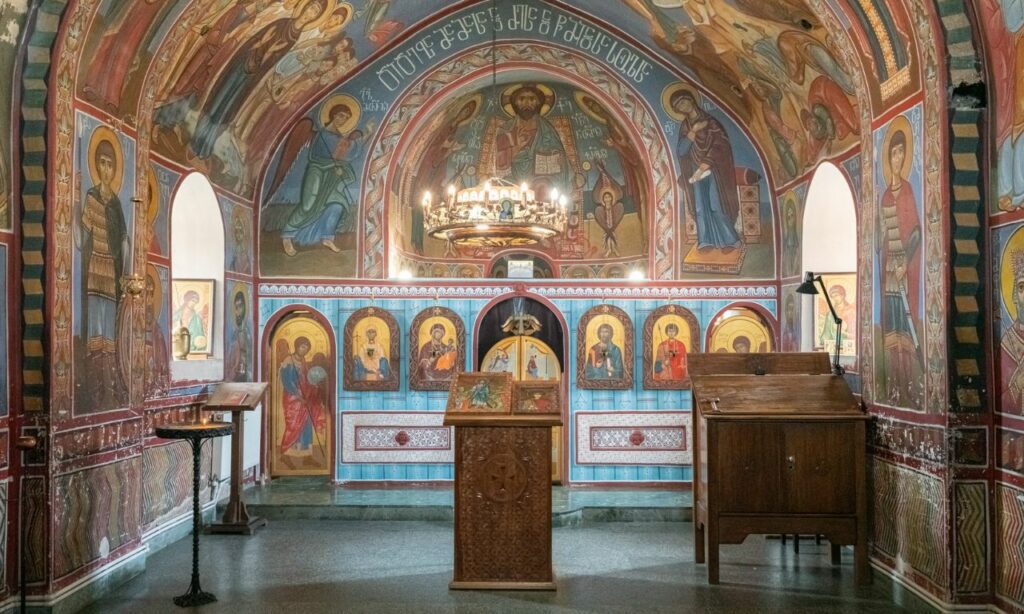
On the boundary of Tbilisi and Kvemo Kartli. Any trip from Tbilisi old town to Bolnisi will take you past the 12th century Shavnabada monastery.
Famous for its ties to St. David Gareja (the more impressive David Gareja cave monastery near Udabno is great if making a trip to Kakheti), one of Georgia’s revered ascetic fathers, the monastery continues to produce wine using centuries-old methods.
They are famous for the extended aging of wines in qvevri, sometimes for up to 10 years. It’s possible to buy a 10+ year-old bottle from the monastery shop, and a tasting room is planned to open in late 2023. Once open, this monastery could raise its tourist profile a lot!
Food & Wine Bolnisi & Kvemo Kartli
Bolnisi Historic German Wine Cellars – Wine Tasting and/or Supra (Feast)
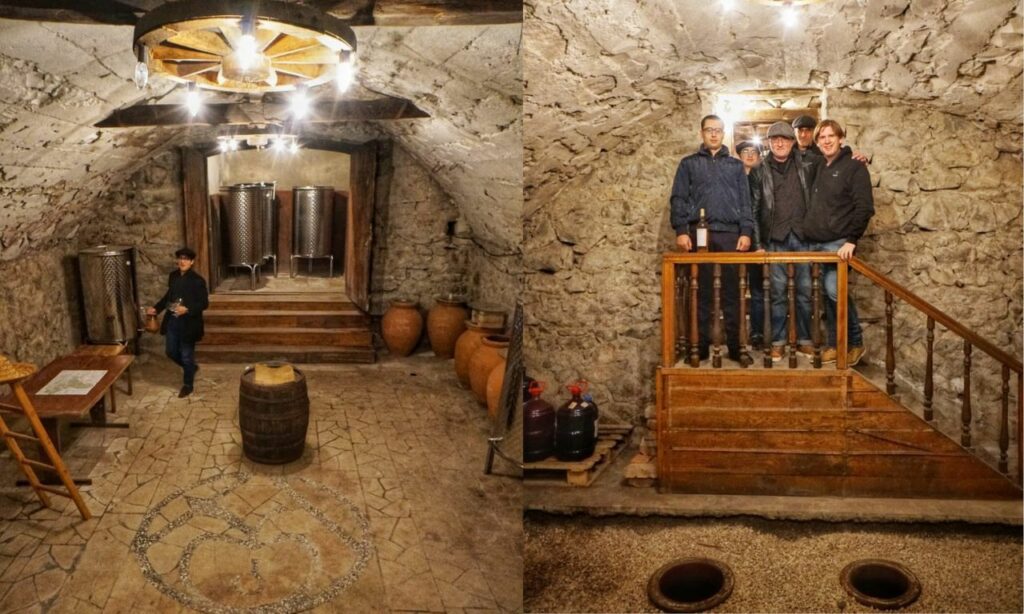
We discussed Bolnisi’s history above. Now, visit the 19th-century wine cellars for yourself! In the traditional style, some are 2-tiered construction with an upper cellar and a much deeper lower cellar. The lower cellars are deeper than a typical Georgian marani would be. But also quite a few are 1-tiered.
There are quite a lot of German cellars in Bolnisi (50+ at least), however, only a few are open to the public, and almost all of those are privately owned and booking is normally essential. Though, for wine tasting without food, it’s sometimes possible, if they are even at home, to just turn up.
For a quick tourist stop the new German House Project renovation (opened June 2023) showcases a smaller 1-tier cellar, and represents wines from many local producers. Here you can also learn a little about the other buildings of Bolnisi. Reservations may be required.
But, for the real Bolnisi food and wine experience, booking a wine tasting and/or dinner at one of the home wineries with a German cellar is a must. Expect copious amounts of Artisan wine and a feast of traditional dishes – a mix of Georgian (mainly) and some German dishes, but it depends on who you visit. All menus are seasonal, request the menu at the time of booking to avoid disappointment.
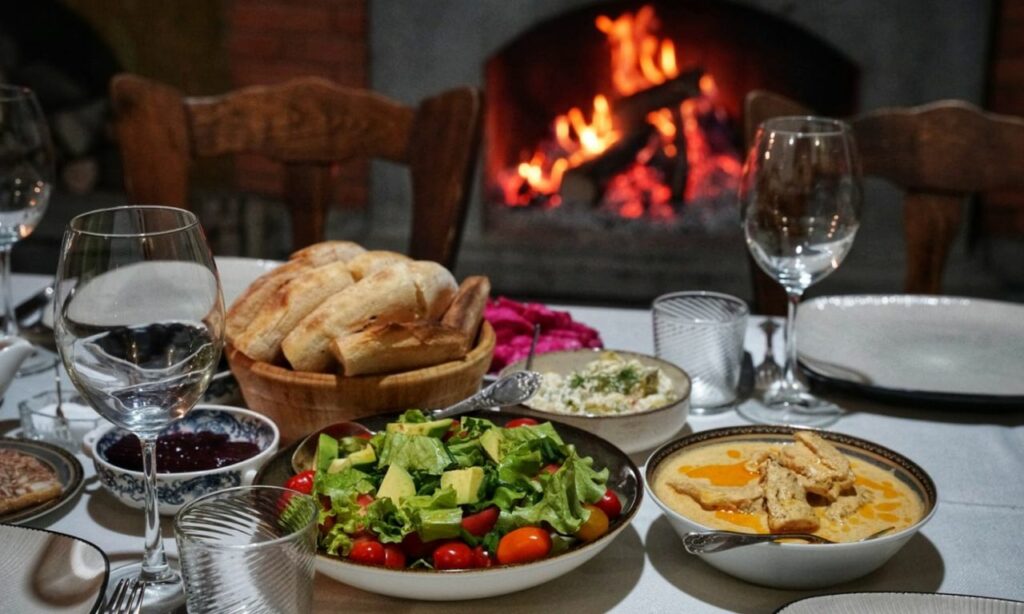
- Shalo’s Cellar. Homemade German ham. 2-tiered cellar. Excellent local wines made using some German techniques and old equipment. Minimal English.
- Dzmebis Marani. 2-tiered cellar. Extensive variety of artisan wines made in Georgian and German style. As well as local grapes, you’ll find Reisling, Chardonnay, and more. The younger son speaks English, the winemakers don’t.
- Levan Kukchishvili Wine Cellar. 1-tier cellar, in the heart of the old city streets. Fantastic homemade food. Levan is a professional level musician and speaks English.
- Khmelo Wine Cellar. 1-tier cellar. Exceptional wines. Minimal English.
Find all the locations on the map below!
NOTE: These people’s homes, not restaurants. Everything is subject to change and at the discretion of the owners.
Asureti Georgia: Historic German Wine Cellars – Wine Tasting and/or Supra (Feast)
Asureti is a significantly smaller settlement but still has some good places on offer.
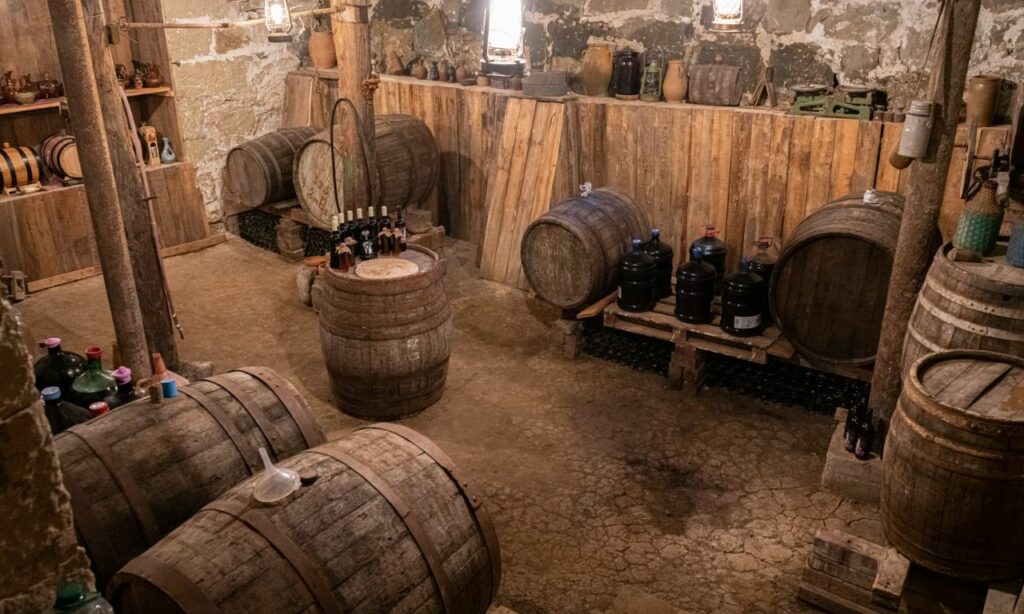
The situation is approximately the same, mostly book in advance, but sometimes you can just turn up and get a wine tasting.
- Chigo Wines. This new project opened in summer 2023, showcases a selection of local winemakers. So this is mainly a stop for wine tasting, and it’s right on the historic walking street.
- Raminashvilis Wine Cellar. Amazing German cellar – not overly renovated so it retains a lot of original rustic charm. Typical homemade wine and food. Worth a visit just for the cellar even if you don’t drink wine!
- Vaso Papa’s Wine Cellar. Amazing food and wine. The renovation of the cellar is over-done in my opinion, which lets the otherwise excellent experience down a bit, it feels too artificial and not like a historic cellar.
Find all the locations on the Bolnisi Georgia map below!
German Style Brewery in Bolnisi
Though beer-making arrived in Georgia probably in the Bronze Age, by way of Egypt and other early brewing cultures, wine has always been the dominant alcohol in Georgia, except in mountain regions where grapes did not grow.
The arrival of German immigrants brought beer-making to Bolnisi, implementing the production methods of Germany. The main central brewery seems to be a mostly modern affair, and it’s pretty small, but the beer is tasty. You can go in and purchase beer to take away or visit the “Marani” restaurant next door who serve the beer at very reasonable prices.
Bolnisi Municipal Market & Bakeries
The local farmer’s market (fresh produce) extends into nearby streets where there are also supermarkets and other shops. A small bakery selling Georgian-style bread, lobiani, khachapuri etc. is on the main street outside the market. Another bakery, slightly east along the same street, sells ciabatta shaped but some sort of German-style bread that is great.
A 15 to 30-minute stop to explore and snack is enough, as it’s not a big market. But the valley is known for its fertility and produce, and plenty of domestic produce which you buy in Tbilisi may come from this area. Try it at the source, for half the price!
Restaurants in Bolnisi
Currently, the options are quite limited. Beyond the below options, there are also some basic eateries – like shawarma and bakeries. As tourism develops, we anticipate more restaurants!
Golden Fish Restaurant, Kvemo Bolnisi
Probably the best restaurant in the area, but you have to drive 15 minutes out to Kvemo Bolnisi. Enjoy the yard, and eat fish directly from the fish farm there. They also have meat and vegetarian options. All typical Georgian cuisine.
“Marani” Restaurant in Bolnisi
Attached to the brewery, the beer is very affordable and great! There is no English menu – the waitress is the menu – and due to the language barrier, you should arrive with a list of traditional dishes and just ask which they have that day. Khinkali, Khachapuri, Salad, Mtsvadi (pork bbq), Qababi etc.
This restaurant has some seating right on the street (not ideal when hot and dusty) and a load of private air-conditioned cabins (which are a little depressing, especially if just 2 people dining, plus I think they still allow smoking in here for some reason). But the food is good, and staff are helpful. It’s also absurdly cheap.
Deutsche Muhle Hotel & Restaruant
The converted mill house, which is now a 3-star hotel and restaurant. The opening hours are inconsistent, as is the service. If the hotel has lots of guests, it may be open, if not it may be closed or if open you may not get much food options or service.
On the positive side, they have a lovely terrace by the river, the interior is also nicely done, and they actually have a menu and a wine selection. Really, this should be the best, most premium option in town, but it falls short of expectations. I hope the management solves some of the issues soon as it’s a lovely place.
Asureti: Station Restaurant
A small restaurant just at the far south end of the walking street. Outdoor and indoor seating, classic cuisine. As most of the other dining options in town are people’s homes, this is the only real alternative, fortunately, it’s very pleasant. Still advisable to call ahead and check if they are open.
Tsalka / Dashbashi
Diamond Restaurant
This restaurant hangs in the middle of the diamond bridge, stretching across Dashbashi Canyon. You can’t really beat it for the unique location. The food and service are adequate for what is a unique and touristy restaurant. Prices, not surprisingly, are inflated. But, you are really paying for the location, not anything else.
Pontia
A typical local restaurant in the heart of Tsalka. Much beloved by locals, you’ll get all the traditional Georgian dishes you’d expect and the typical provincial vibe of a restaurant in a town that doesn’t get huge amounts of tourism. Prices are low, of course, compared to Tbilisi.
Artisan Cheese Producers in Tsalka
Why not try some local cheese while you are nearby?
- Milk Factory Marita – A 20-minute drive from the edge of Tsalka lake. They only just started accepting tourists in 2023, it doesn’t have much infrastructure for this but they can make up for that with raw authenticity.
- Coocou Hostel – On the banks of Tsalka lake, they have been known to make cheese, but call ahead to check if they will have any when you visit. A simple garden vibe to enjoy a drink, provided they are open.
Where To Stay: Accommodation in Bolnisi & Kvemo Kartli
Bolnisi:
- Deutsche Muhle Hotel – 3-Star. The converted millhouse is impressive on the outside. The rooms are decidedly 1980’s 3-star on the inside, but the terrace and restaurant areas are lovely. The location is a short walk from the historic center. Service, as mentioned above, is inconsistent. Do they answer emails or the phone, occasionally…
- Guest House Bolnisi – Small family guesthouse with recently renovated apartments and helpful owners. Nice garden.
- Bolnisi Guest House – Not connected to Guest House Bolnisi, lol. Another friendly home guesthouse.
- Jeffery+. Basic modern rooms, family guesthouse.
- Prime House. Older, basic rooms. Interesting place with a pool table and a swimming pool (if it’s got water in it).
Tetriskaro / Tsalka / Dashbashi
- Kass Land Diamond Resort – Dashbashi. 4 Star hotel right next to the diamond bridge and canyon.
- Artist’s House – Tetriskaro. Family guesthouse full of artworks with real family hosting for homemade dinner and wines. Note this is almost an hour from Dashbashi and is closer to Asureti and Bonisi.
- Family Hotel Maia – Dashbashi. Modern but simple lodgings.
- Panorama Dashbashi. Brand new wooden cabins with views towards the canyon. 2-star.
- Coucou hostel – Tsalka Lake. Basic budget rooms on the edge of the lake with a backpacker vibe.
TOURIST MAP: Kvemo Kartli & Bolnisi Map
 If you want a fully guided, all-inclusive trip with plenty of food and wine to try, and an expert guide to do the driving for you, please check out Eat This! Tours. Currently, they offer Bolnisi routes on-demand, but as the region grows more popular, scheduled tours will become available.
If you want a fully guided, all-inclusive trip with plenty of food and wine to try, and an expert guide to do the driving for you, please check out Eat This! Tours. Currently, they offer Bolnisi routes on-demand, but as the region grows more popular, scheduled tours will become available.
Get Our Free Georgian Wine Crash Course & Wine Tasting Card / Guide
For a crash course in everything you need to know to get familiar with Georgian wines, download our Georgian wine crash course mini eBook. You’ll also get our printable wine tasting review card and guide so you can understand how to taste and appreciate Georgian qvevri wines.
Bolnisi Region Itineraries
If you want a fully guided, all-inclusive trip with plenty of food and wine to try, and an expert guide to do the driving for you, please check out Eat This! Tours.
OR You can book a transfer driver with GoTrip.
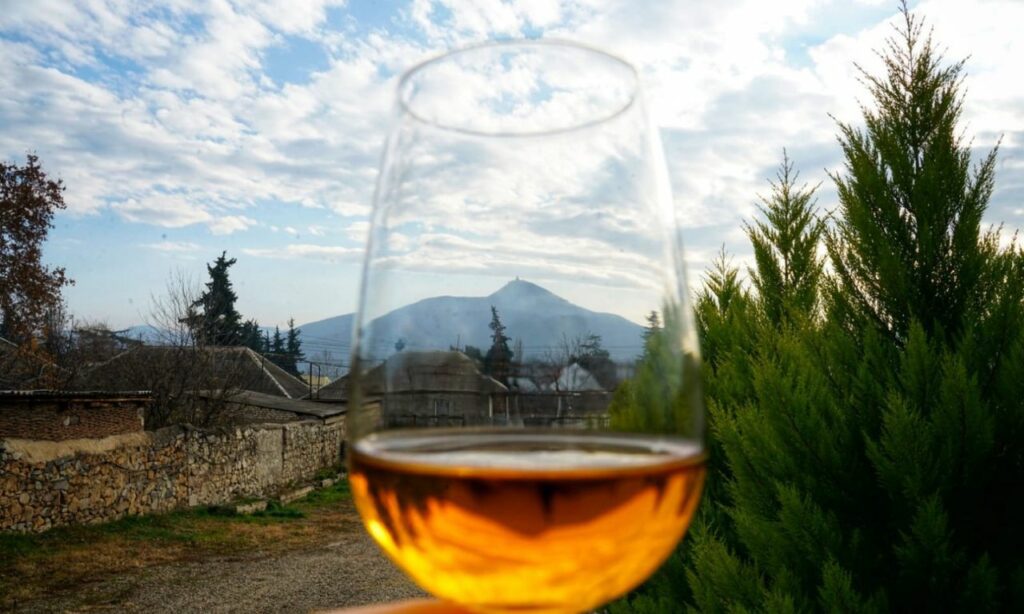
1 Day Bolnisi Itinerary (inc. Asureti)
This is a fast 1-day trip that takes in the major highlights.
- Drive from Tbilisi to Bolnisi historic center for a short walk around the historic buildings.
- Drive from Bolnisi to Dmanisi Archeological Site (Seasonal May to Oct, but varies). If out of season, visit Bolnisi Museum Instead.
- Return to Bolnisi for lunch. Visit a 19th-century German cellar. Wine tasting and a home-cooked meal (advanced booking essential, premium option). OR make a stop at a local restaurant for local beer and khinkali (budget option)
- Drive up to the Zedashe for panoramic valley views.
- Drive through Samshvilde Canyon. A stop at the Samshvilde Fortress requires at least 1 hour, so it’s a bit tight for a short day. The access road needs a 4×4 if it has rained recently.
- Drive to Asureti. Explore the old German street and church.
- Return to Tbilisi.
2 Day Bolnisi Itinerary
This 2 day trip takes in the major highlights, and some extras, and allows for a more relaxed trip.
Day 1.
- Depart Tbilisi. Stop at Shavnabada monastery for a quick visit.
- Make a brief 20-minute stop at Kveshi Fortress.
- Drive to Dmanisi Archaeological Site (Seasonal May to Oct, but varies). If out of season, visit Bolnisi Museum Instead.
- Return to Bolnisi for lunch. Visit a 19th-century German cellar. Wine tasting and home-cooked meal (advanced booking essential, premium option). OR make a stop at a local restaurant for local beer and khinkali (budget option)
- Drive up to the Zedashe for panoramic valley views.
- Visit Bolnisi Sioni Cathedral.
- Enjoy a relaxed evening at your guesthouse. Or eat dinner at a local restaurant or winery (if you do the winery lunch feast, a second feast for dinner is a big day! Great if you have a driver/guide though).
Day 2.
- Take a morning stroll around the Bolnisi historic center.
- Visit Bolnisi museum (if you didn’t on Day 1) to learn about the 8000-year wine history, and about the German settlement of the area.
- Enjoy lunch at a winery or local restaurant in Bolnisi.
- Drive through Samshvilde Canyon. A stop at the Samshvilde Fortress requires at least 1 hour, so its a bit tight for a short day. The access road needs a 4×4 if it has rained recently.
- Drive to Asureti. Explore the old German street and church. Stop at one of the local wineries for wine tasting.
- Return to Tbilisi.
3 Day Bolnisi & Dashbashi Itinerary
This 3-day trip extends the option to visit some of the more out-of-the-way locations like Dashbashi Canyon, at a comfortable pace.
Day 1.
- Depart Tbilisi. Stop at Shavnabada monastery for a quick visit.
- Drive to Asureti. Explore the old German street and church.
- Drive to Bolnisi and up to the Zedashe for panoramic valley views.
- Return to Bolnisi for lunch. Visit a 19th-century German cellar. Wine tasting and home-cooked meal (advanced booking essential, premium option). OR make a stop to a local restaurant for local beer and khinkali (budget option)
- Visit Bolnisi Museum to learn about the 8000-year wine history, and about the German settlement of the area.
- Visit Bolnisi Sioni Cathedral. In Kvemo Bolnisi.
- Visit Bolnisi historic center for a short walk around the historic buildings (1 hour).
- Enjoy a relaxed evening at your guesthouse. Or eat dinner at a local restaurant or winery (if you do the winery lunch feast, a second feast for dinner is a big day! Great if you have a driver/guide though).
Day 2.
- Enjoy a relaxed breakfast.
- Make a brief 20-minute stop at Kveshi Fortress, on the way to Dmanisi.
- Drive to Dmanisi Archeological Site (Seasonal May to Oct, but varies). If out of season, visit Bolnisi Museum Instead.
- Return to Bolnisi, and enjoy lunch at a winery or local restaurant in town.
- Drive through Samshvilde Canyon. A stop at the Samshvilde Fortress requires at least 1 hour, so it’s a bit tight for a short day. The access road needs a 4×4 if it has rained recently.
- Drive on to Dashbashi / Tsalka. Visit a small local cheese producer (optional) Explore the lake area and have a relaxed evening at your accommodation.
Day 3.
- Visit Dashbashi Canyon and the new diamond bridge. You can spend 2 hours here if hiking to the main waterfall.
- Have lunch before departing the Dashbashi area.
- Head to Manglisi Cathedral.
- Drive up to Didgori War Memorial for lovely views.
- Drive over the other side of the mountain to Mtskheta.
- Visit Mtskheta and Jvari Monastery (UNESCO).
- Return to Tbilisi.
 If you want a fully guided, all-inclusive trip with plenty of food and wine to try, and an expert guide to do the driving for you, please check out Eat This! Tours. Currently, they offer Bolnisi routes on-demand, but as the region grows more popular, scheduled tours will become available.
If you want a fully guided, all-inclusive trip with plenty of food and wine to try, and an expert guide to do the driving for you, please check out Eat This! Tours. Currently, they offer Bolnisi routes on-demand, but as the region grows more popular, scheduled tours will become available.
OR You can book a transfer driver with GoTrip.


